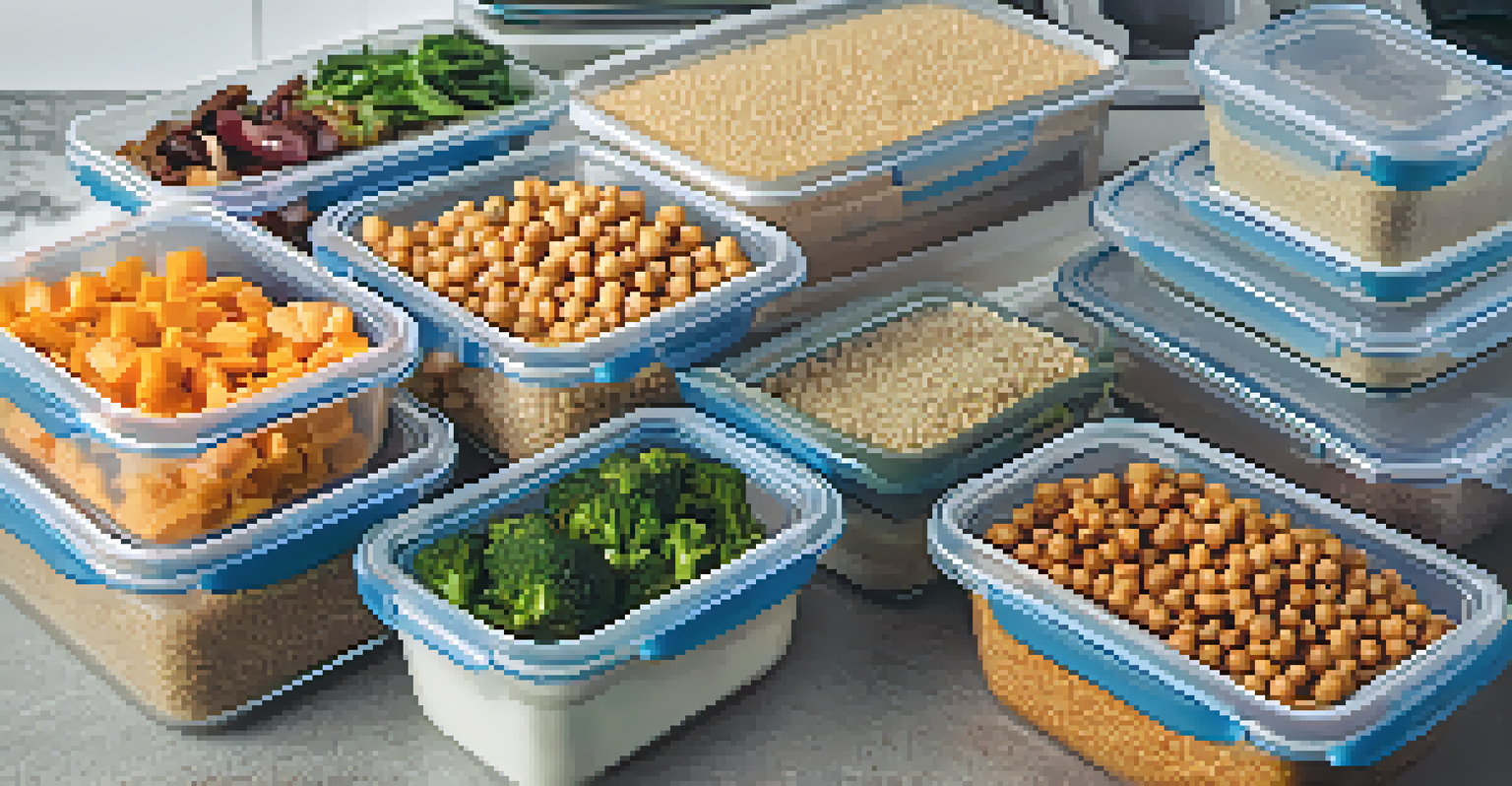How to Meal Prep for Optimal Protein Intake

Understanding Protein's Role in Your Diet
Protein is a vital macronutrient that helps build and repair tissues, making it essential for overall health. It plays a significant role in muscle growth, immune function, and even hormone production. By understanding how protein works in your body, you can make more informed decisions about your meal prep.
Let food be thy medicine and medicine be thy food.
When you consume protein, your body breaks it down into amino acids, which are the building blocks for many bodily functions. Different types of protein sources provide varying amino acid profiles, so it's important to include a variety in your diet. Think of protein as the bricks that build your house; without the right materials, the structure won't hold.
By prioritizing protein in your meals, you're not just fueling your body; you're also supporting better recovery after exercise and helping control hunger and cravings. This is especially useful if you're trying to maintain or lose weight, as higher protein diets have been shown to promote satiety.
Choosing the Right Protein Sources for Meal Prep
When meal prepping, the first step is selecting high-quality protein sources that suit your lifestyle and dietary preferences. From lean meats like chicken and turkey to plant-based options like lentils and tofu, there’s a wide variety available. Consider your personal taste and nutritional needs when making these choices.

Incorporating both animal and plant-based proteins can provide a balanced amino acid profile. For instance, chicken breast is a lean source of protein, while quinoa offers complete protein from a plant source. Mixing different types of protein can not only enhance flavor but also maximize nutritional benefits.
Protein Fuels Health and Recovery
Incorporating adequate protein into your diet supports muscle growth, immune function, and effective recovery after exercise.
Don’t forget about convenience! Pre-cooked options like canned tuna or rotisserie chicken can save you time during busy weeks. Having these easy-to-prepare protein sources on hand makes it simpler to stick to your meal prep goals.
Planning Your Weekly Meals with Protein in Mind
Creating a weekly meal plan is a crucial step in optimizing your protein intake. Start by mapping out your meals for each day and ensure that each one includes a protein source. This not only helps you stay organized but also makes it easier to hit your protein targets.
Protein is the building block of life; eat it to feel alive.
Consider cooking in bulk to save time and effort. For example, you could prepare a large batch of grilled chicken or a hearty bean chili that can be portioned out for several meals. This strategy not only saves time but also helps reduce food waste.
Don’t forget to include snacks that are high in protein as well! Greek yogurt, nuts, or protein bars can be great options to keep your energy levels steady throughout the day. A well-rounded meal plan will keep you full and satisfied while meeting your protein needs.
Batch Cooking: The Key to Efficient Meal Prep
Batch cooking is a game-changer when it comes to meal prepping for optimal protein intake. By preparing large quantities of protein-rich foods at once, you can save time and ensure you have healthy options ready to go. Think of it as a time investment that pays off throughout the week.
One effective strategy is to dedicate a day, like Sunday, to cooking and preparing your meals for the week ahead. You could roast several chicken breasts, boil eggs, or cook a large pot of lentils. Having these proteins prepped allows you to mix and match them throughout the week, keeping your meals interesting.
Diverse Protein Sources are Key
Selecting a variety of protein sources, both animal and plant-based, ensures a balanced intake of essential amino acids.
Storage is also key! Invest in quality meal prep containers that can easily be stacked in your fridge. This organization not only saves space but also makes it simple to grab a healthy meal when you're on the go.
Incorporating Variety to Keep Meals Exciting
One of the biggest challenges of meal prep is keeping your meals exciting and enjoyable. Eating the same protein source repeatedly can lead to boredom and may tempt you to stray from your meal plan. To avoid this, experiment with different cooking methods, spices, and sauces.
For instance, if you grilled chicken one week, consider baking it with different herbs and spices the next. You could also switch things up by rotating in different proteins, such as fish, beans, or lean pork. This variety will help you stay motivated and make meal prep something you look forward to.
Additionally, consider incorporating seasonal vegetables and grains that complement your proteins. A colorful plate not only looks appealing but also adds nutritional diversity to your meals, enhancing both flavor and health benefits.
Smart Storage Tips for Protein-Rich Meals
Once you've prepared your protein-rich meals, proper storage is essential to maintain freshness and flavor. Utilize airtight containers to keep your food safe from spoiling and to preserve taste. Labeling your meals with dates can also help you keep track of what needs to be consumed first.
For longer storage, consider freezing portions of your meals. This is especially useful for foods like stews, soups, or cooked grains. Just be sure to use freezer-safe containers to avoid freezer burn, which can negatively affect the quality of your meals.
Meal Prep Enhances Protein Intake
Planning and batch cooking meals can help you efficiently meet your protein goals while keeping your diet interesting.
Also, remember to cool down your meals before placing them in the fridge or freezer. This helps prevent excess moisture, which can lead to sogginess or spoilage. By following these storage tips, you can enjoy your protein-rich meals throughout the week without worrying about quality.
Evaluating Your Protein Intake and Adjusting as Needed
As you embark on your meal prep journey, it’s important to evaluate your protein intake regularly. Monitoring how much protein you consume can help you determine if you're meeting your nutritional goals. Tools like food tracking apps can be valuable for keeping an accurate log.
Listen to your body! If you find you're feeling sluggish or not recovering well from workouts, it may be a sign to boost your protein intake. This could mean adding an extra serving of protein at meals or incorporating higher-protein snacks throughout the day.

Finally, don't be afraid to tweak your meal prep strategies as you learn what works best for you. Everyone’s protein needs and preferences are unique, so being flexible and open to change will help you succeed in maintaining optimal protein intake.